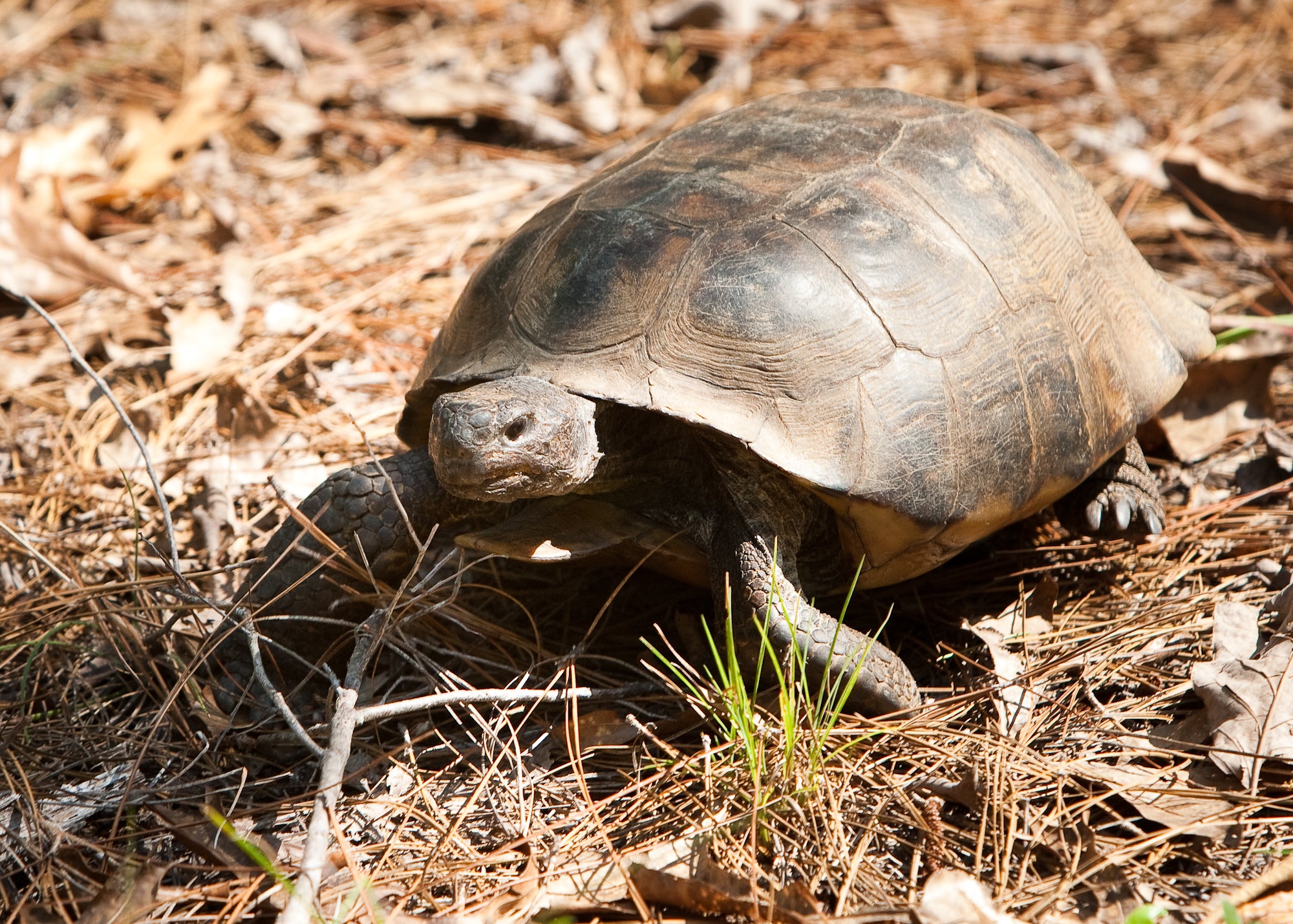Different agencies are offering cost-share for habitat management – incentives for habitat management like prescribed burning. WFF, AFC and other partners have secured grants to provide gopher tortoise surveys on private land free of charge. Several agencies and organizations offer technical assistance on improving habitat.
The verified gopher tortoise populations in Alabama are in the Conecuh National Forest and Fort Rucker near Enterprise, Ala. A follow-up survey is ongoing on Fort Rucker.
“Conecuh has one viable population and Fort Rucker has one,” Shelton-Nix said. “Those are our largest, most contiguous blocks of land with high-priority gopher tortoise soils. It is likely there are others that have yet to be identified in Alabama, but we are working on it.”
Gopher tortoises are mostly limited to deep, sandy soils that make construction of their burrows easier.
The preferred gopher tortoise habitat is open-canopy pine forests with no mid-story growth that allows light to reach the forest floor to promote an abundance of herbaceous ground cover for tortoise forage.
“A species that becomes reproductively mature that late in life, combined with high nesting and hatchling predation rates, creates a long lag time for a tortoise to contribute to a population,” Shelton-Nix said. “In poor habitat, we see small isolated islands, like wildlife openings and roadsides, with only a handful of tortoises. Remember this is a long-lived species. As habitat quality decreases, tortoises will move to areas with food availability. They will survive, but they are not reproducing, therefore, not a viable population. That’s why the social structure is so important.”
The USFWS will consider the three Rs – representation, redundancy and resiliency – during deliberation on the gopher tortoise listing status. Representation covers where it is important to have tortoises on the landscape factored with population level. Redundancy refers to multiple populations that are needed per unit to protect against unit-wide extirpation (local extinction). Resiliency refers to populations large enough to protect against extirpation by catastrophic events.
Shelton-Nix said owners who agree to participate should expect a site visit from biologists to determine suitable habitat.
“We have a limited amount of survey dollars,” Shelton-Nix said. “We need to determine the percentage of suitable soils. We are looking for landowners with 50 or more burrows, so we can be efficient and get the most bang for our bucks.”
If the property is deemed suitable for a survey, the WFF grant will cover the cost of a consultant to conduct a survey, using the Line Transect Distance Sampling method. Each burrow that is found is scoped with video equipment to check for the presence of animals, which helps determine density rate.
Shelton-Nix said the number of burrows doesn’t translate to the number of tortoises.
“Each gopher tortoise can make three to five burrows,” she said. “If someone has 10 burrows on their property, most likely they have two to three tortoises.”
Shelton-Nix said 140 folks attended the four workshops with 30 landowners who were interested in being surveyed.
“We received great feedback,” she said. “But we’re still finding people who didn’t know they are being considered as a threatened species. The gopher tortoise is a very charismatic species, and people who have them love their tortoises.”
The exception are cattle and horse owners who are worried about the burrows.
“There are easy fixes around that,” Shelton-Nix said. “If people call me, we want to help people find solutions to their problems. It is illegal to move them. Another thing unique about gopher tortoises is they have a homing instinct. If you move them, they’re just going to try to go back home and may end up squished on the highway.”
Ray Metzler, who is the AFC’s threatened and endangered species coordinator, said the effort must overcome the concern from citizens when they hear, “We’re from the government and we’re here to help.”
“We do have ways to provide the information to the USFWS without actually sharing names and addresses,” Metzler said. “We can just tell them that Landowner A has 175 tortoises in Escambia County with a density of whatever. That’s not intrusive and doesn’t share any private information.”
Metzler said the impact of the USFWS decision on the gopher tortoise can’t be determined right now.
“We don’t know if they (USFWS) would limit activities related to the tortoise,” Metzler said. “There might not be any impacts. We really don’t know. The USFWS won’t say until they review the information provided by the states to make the decision. Our goal is to keep it from being listed.
“We are trying to get more private landowners engaged in the process and hopefully allow us to come to their property and do a survey.”
Metzler hopes to acquire more grant money for more outreach to the affected landowners later this year.
“Our first four meetings led to more landowners finding out about the need for this program,” he said. “We’ve actually been on a few pieces of property that we didn’t know existed, that have good habitat and have some tortoises. If we have a few more meetings, it might lead to a few more properties like that.”
Although current research sets a viable population at 250 animals at a certain density, Metzler thinks support populations could have considerably lower numbers.
“You might have a support population at 50 tortoises,” he said. “There’s probably a lot more properties that have 50 tortoises as opposed to 250 at the appropriate density. And we need to find those properties.”
Visit www.outdooralabama.com/nongame-wildlife-species-projects/gopher-tortoise-project for a variety of information, including on the Alabama Tortoise Alliance, which will meet February 28 in Andalusia.
###







